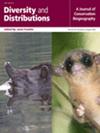Climate Change Impacts on Antarctic Fish Diversity: A Circumpolar Perspective From eDNA Metabarcoding Assessment
Abstract
Aim
Recent climate-driven changes in the Antarctic marine environment, marked by regional differences between West and East Antarctica, may alter ecosystem dynamics. As key components of the food web, fish might reflect these changes. This study examines fish biodiversity patterns across four typical Antarctic seas by integrating eDNA analysis with bottom trawl surveys, focusing on biodiversity shifts and range alterations in response to varying levels of climate change exposure.
Location
Four ecologically distinct Antarctic regions: The Adjacent Waters of Antarctic Peninsula (AAP), the Amundsen Sea-Bellingshausen Sea (ASBS), the Prydz Bay-Cooperation Sea (PBCS), and the Cosmonaut Sea (CS).
Methods
During the 37th Chinese National Antarctic Research Expedition, we integrated eDNA metabarcoding (from both pelagic and benthic water layers) with bottom trawl surveys across four regions (AAP, ASBS, PBCS, and CS) to characterise regional fish community.
Results
Environmental DNA metabarcoding and trawl surveys detected 40 and 27 Antarctic fish species, respectively. Environmental DNA proved effective in complementing traditional methods and capturing early life stages, especially with a refined local reference database. Species belonging to the suborder Notothenioidei dominated across all surveyed regions. Ten species exhibited range extensions beyond previously documented distributions, likely reflecting historical data gaps, with the exception of Patagonotothen sp.
Main Conclusions
eDNA metabarcoding showed potential for monitoring Antarctic ichthyoplankton. Fish diversity in the four studied seas aligns with the general pattern in the Southern Ocean, while ASBS was identified as a previously overlooked fish diversity hotspot. The southward detection of Patagonotothen sp. may signal climate-driven shifts in species distribution. Future research integrating eDNA with interdisciplinary approaches holds promise for advancing the monitoring of climate change impacts on Antarctic marine ecosystems.


 求助内容:
求助内容: 应助结果提醒方式:
应助结果提醒方式:


